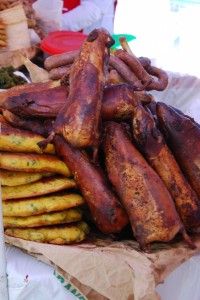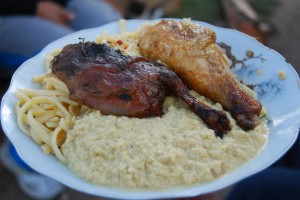Guinea Pig, Pet or Festive Meal

“Did you know that in other countries they don’t eat guinea pig” said the one young man to the other while seated on benches in the Plaza de San Blas.
“What? You’re kidding, right?”
“They don’t eat guinea pig, like we do. For them the guinea pig is a pet and the idea of eating them disturbs them just like for us eating dog would be weird.”
“But guinea pig is sooo good.”
Like these two young men in their late teens who on a sunny day were resting from handing out advertisements to tourists, the people of Cuzco are very aware and fascinated by the customs of outsiders.

But, this same fascination is found among many of the tourists. As a result, eating cuy, or guinea pig, despite their being considered pets at home, is something many more adventuresome tourists wish to try.
Restaurants around the colonial core of Cuzco often offer roast guinea pig to their clients. While some send a runner to the market to buy guinea pig from vendors specialized in their cooking, before re-plating it and selling it to the tourists, others prepare the guinea pig on site and have organized chains of production stretching into the remote countryside.
Garcia relates (p 22) that the Inka Grill restaurant, located on the Plaza de Armas at the corner of Plateros street, obtains its guinea pigs from exclusive arrangements with farmers hours away from Cusco who raise them organically.
The farm was located in a fertile inter-Andean valley. Stunning views of Andean hills framed two frolicking puppies, who playfully approached the recently created trout pond, looking at don Wilbert, the owner of the farm, and the hundreds of guinea pigs housed here. In a large, clean, enclosed area, guinea pigs of all sizes squealed and huddled toward the back of their pens as we walked into the enclosure. The very friendly and welcoming don Wilbert proudly showed off his cuyes, pointing to those who were especially plump, or pregnant.
Garcia continues to claim (p. 29) that this market in commercially raised guinea pigs is not just for the tourist restaurants of Cuzco, such as Inka Grill, but also is increasingly for export. She cites “recent reports” that more than twenty tons of frozen guinea pig are exported to the US each year.

While this meat is probably consumed primarily by Peruvian and other Andean immigrants to the Untied States, nonetheless Peruvian restaurants in North America and Europe are increasingly offering Guinea pig on their menu as something that can symbolize the “authenticity” of their offerings especially since the meat is generally considered to belong to a pet and not a food animal in those countries.
In Cuzco, the cuy (or guinea pig) is an important food. Not consumed daily, it is prepared instead for birthdays and feast days. Rosario Olivas Weston writes that the cuy provides the most valuable meat and is eaten on all the feast days (p. 16).
Hence the astonishment of the two young men. But, there is more. Most cuyes eaten by the local people of Cuzco are not produced on commercial farms. rather they are raised in family homes and especially kitchens.
Morales notes that “Cuy[e]s are such an expected part of the Andean household that families who do not have cuy[e]s in their kitchen are considered to be lazy or extremely poor.” (p. 132) He focuses on rural peoples and working class urban families and so we might add upper class families as ones who do not have cuyes living in their kitchens, although they may have a pen in their yards.

Puga (quoted in Benavides pp. 85-90) relates the importance of household animals in the diet of traditional Peruvians. Even people in the cities will often have chickens, ducks, and guinea pigs in their homes. But unlike outsiders, for whom household animals become pets and therefore inedible, here the intimacy of the animals with the people gives them more importance for consumption.
Especially for the children, but also for many adults, the sacrifice of a pig, a certain chicken, or the [guinea pig], would bring sadness to such a degree that we could refuse for a while to eat them, until the voice of wisdom would sound the sentence ‘Did you love them? Did you play with them? Then eat them and thus they will continue living within you.’
Puga also notes that the guinea pigs tended to live in the most symbolically central part of the home, the kitchen. In many cusqueños minds guinea pigs are strongly associated with the hearth and with the idea of food.
It is not surprising that guinea pig should be so highly valued as a food for rites of passage and other feasts since it, almost more than any other food, can symbolize the idea of food and the hope for future food, as well as the strong lesson of closeness and sacrifice.

Of course, when someone from the outside orders cuy from a restaurant’s menu, not only is the meat coming from a commercial farm, rather than from someone’s kitchen supply, it comes without the dense set of meanings developed by its close association with people’s lives.
Instead it may represent authenticity, especially the truthiness sought as part of travel to a distant land, and the desire to eat the food of the land in order to experience it more thoroughly.
In this vein, the Inka Grill says that they “offer a fascinating culinary proposal,” a trip through the textiles and textures of the Andean world.” The guinea pig becomes one of the textures of this landscape related to the colorful weavings on the walls.
So, when the two teenagers took break in San Blas and wondered in fascination at tourists who saw guinea pigs as pets, rather than as food, they not only were trying to build a bridge of understanding between different culinary worlds, they were also asserting the power of the cuy in their lives, where it is almost not a feast unless there is guinea pig on the menu.




